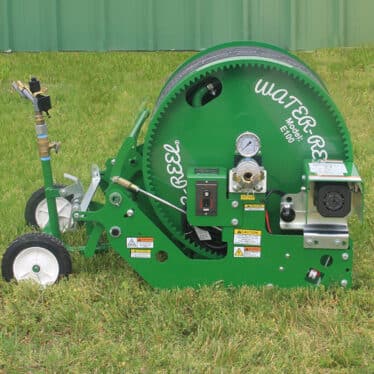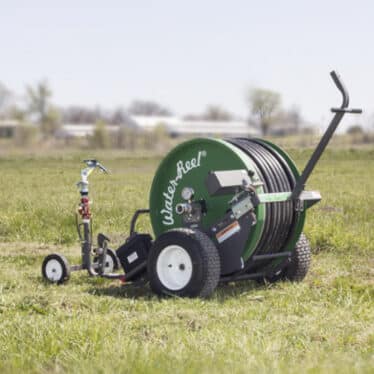Four reasons why watering your arena is one of the best tools available for maintaining a good riding surface.
1. Water provides stability and cushion
Think about walking barefoot on the beach by the water’s edge. You’ll find the sand is stable, yet still has some give to the pressure of your foot. Now think about walking up higher on the beach, where the sand is deep and dry. You will find yourself trudging through, with the surface always giving beneath you. What’s the difference? Well my friends, it’s all about the water.
There is a lot of molecular science we could go into about why water has this affect with sand. However, all you really need to know is that an intermolecular attraction is formed between water molecules that holds sand together that creates stabilization.
When it comes to maintaining your arena surface, water is king. But what can be more important is finding the right amount of water to use on your arena. Just like Goldie Locks and the three bears, it has to be just right. Sand with too much water will be thick and slippery, sand with not enough water will be loose and dusty, and sand with just the right amount of water will be stable yet giving. A good way to tell if you have the right amount of water on your arena is to take a handful of footing and ball it up in your hand and drop it. If the ball gives way on the landing, but mostly stays together then you have the right amount of water.
2. Water will bind sand and textile together for optimum equine biomechanics
Just in the same way water will help hold sand together, it is also crucial in keeping a synthetic additive bound with the sand. But for a moment, let’s go back to the beach. You’re out enjoying your day wading in the waves, you then come in to do some sun bathing and you see that now because your feet and legs are wet, all the sand is sticking to you. Whereas before when you were dry, sand just fell right off.
In this same way water is going to bind your textile additive to the sand that you chose for your arena. Without it, the fibers and sand will separate, creating a clumpy, loose and potentially slippery surface. Water binds sand and fiber together creating a rooting system in your surface. The biomechanics of this are similar to a proper grass surface. A correctly designed and hydrated grass surface will provide the right amount of toe dip, grip, cushion and rebound.
3. Controls dust and other nasty airborne particles
For anyone that has maintained an arena, watering to keep down dust is a no brainer. But what about other airborne particulates? Organic matter, bacteria, fungi and viruses can all be wafting in the air with that dust. Watering is the best way to keep contaminants out of your horse’s lungs and yours as well.
4. Where water-less footings fall short
There are some products on the market that are described as water-less footings. What that means is the sand has a wax or polymer coating. Where water is the same consistency from 33 degrees to 211 degrees, waxes, polymers or oils can change in consistency from hot to cold. Synthetic coated sands may seem like a good idea, but if you live in an area with drastically changing temperatures throughout the year, you may find your surface to be sticky and gooey in the summer, and clumpy and hard in the winter. A good example is to go back to the beach and make a sand castle with ocean water then try and make one with candle wax. You will immediately see how quickly the particles will change depending on the temperature.
There are some products on the market that are designed to aid in water absorption but are not a water alternative. We offer two products like this, HydroKeep and SlowDust. While they are both designed to reduce watering, they do not eliminate it. HydroKeep has crystals that absorb water and retain it. Over time as the soil dries, the crystal contracts, gradually releasing water and hydrating the surrounding area.
SlowDust simply charges the neutrally charged dust particles floating in your arena to a negative state (flocculation). Once charged the dust will be pulled down and no longer be suspended in the air. Moisture will be retained to an optimal state and can reduce the need to water an arena by minimum of 50 percent.
Magnesium Chloride has also become a popular product for indoor arenas, as it takes moisture out of the air to hydrate the arena and prevents freezing. Mag Chloride can be difficult for outdoor applications, as it can be degraded by a single rainstorm. Magnesium Chloride can be found online and at local home improvement stores. In particularly dry climates, indoor areas treated with Magnesium Chloride can be lightly misted with a hose or sprinkler to help create moisture in the air for the Magnesium Chloride to absorb.
Water – it’s the best of everything
While water is a precious and sometimes costly resource, there really is no better solution for maintaining a quality arena surface. Between keeping down dust, and contributing to a more stable surface, water can be one of your greatest allies in maintaining and preserving your arena.
SHOP OUR ARENA HYDRATION PRODUCTS
-
Sale!
Slow Dust – Dust Control 18 lb bucket
Original price was: $299.00.$269.10Current price is: $269.10.Covers 12,000 to 15,000 sq ft
Free Shipping in the contiguous U.S.
© 2018 Premier Equestrian, Inc. All rights reserved
















One Comment